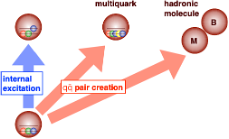Speaker
Description
We investigate the centrality and momentum dependence of X(3872) in heavy-ion collisions via the Langevin equation and instant coalescence model (LICM). When X(3872) is treated as a compact tetraquark state, the tetraquarks are produced via the coalescence of heavy and light quarks near the quantum chromodynamic (QCD) phase transition due to the restoration of the heavy quark potential at $T\rightarrow T_c$. In the molecular scenario, loosely bound X(3872) is produced via the coalescence of $D^0$-$\bar D^{*0}$ mesons in a hadronic medium after kinetic freeze-out. We employ the LICM to explain both $D^0$ and $J/\psi$ production as a benchmark. Then we give predictions regarding X(3872) production and the nuclear modification factor $R_{AA}^{X(3872)}$. We find that the total yield of tetraquark is several times larger than the molecular production in Pb-Pb collisions. Although the geometric size of the hadronic molecule is huge, the coalescence probability is small due to strict constraints on the relative momentum between $D^0$ and $\bar D^{*0}$ in the molecular Wigner function, which suppresses the molecular yield. Based on the same approach, we calculated the $R_{AA}(B_c)$ which can explain well the experimental data published recently.

